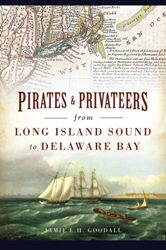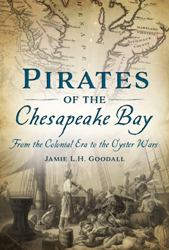 Pirates and Privateers Pirates and Privateers
The History of Maritime
Piracy
Cindy Vallar, Editor
& Reviewer
P.O. Box 425,
Keller, TX 76244-0425
    
Books for Adults
~ History: Pirates
Pirates &
Privateers from Long Island Sound to Delaware Bay
Pirates of
the Chesapeake Bay

Pirates & Privateers from Long Island Sound to
Delaware Bay
by Jamie L. H. Goodall
History Press, 2022, ISBN 978-1-4671-4827-6, US $21.99
    
In the
late seventeenth century, if a pirate needed
protection, one official was happy to oblige. His
name was Colonel Benjamin Fletcher, and he was the
governor of New York. One pirate who sought his
assistance was Samuel Burgess, who originally served
under Captain William Kidd until William Mason
absconded with the Blessed William and
turned to piracy. Burgess went along for the ride,
but circumstances didn’t turn out exactly as he
hoped, so he jumped ship in Madagascar, where he
stayed until sailing to New York in 1693 to seek
Fletcher’s help. And the governor willingly
complied, but Burgess eventually returned to
pirating.
One might think that Fletcher’s collaboration with
pirates was unusual. The fact is, as Goodall shows,
the opposite was true. A number of governors and
colonists associated with these scoundrels, because
they supplied necessities and luxuries that lined
pockets and coffers with money. As a result, piracy
became a major element in the colonies’ economy
during the golden age of piracy. This is what
Goodall examines in the first half of this book. She
discusses New York history, Kidd’s ties to the
colony, his association with Frederick Philipse (the
richest man in New York and a prominent merchant),
Adam Baldridge (Philipse’s storekeeper in Madagascar
who bartered with pirates), the slave trade,
Fletcher’s collusion with pirates as well as that of
Governor Markham of Pennsylvania, the antipiracy
efforts of the Earl of Bellomont and Jeremiah Basse,
and colonial ties with Blackbeard and Thomas Tew, as
well as supposed associations with Bartholomew
Roberts.
As piracy declined and wars erupted in Europe,
privateers take center stage in the second half of
the book. Of particular interest here are those
associated with King George’s War (1744-48) and the
French and Indian War (1754-1763). Privateering
successes bring abundance to the colonies,
especially New York. As a result, the booming
economy leads to job growth. Among the topics
Goodall covers in this section are what happened to
the privateers who were captured, effects on
maritime insurance rates and prices of imports, and
the impact on Black privateers. Two privateers whom
she highlights are the audacious William Reen and
persevering Patrick Dennis, who was captured and
enslaved, but escaped only to sign aboard another
privateering venture.
Corruption, of course, is a main theme throughout
the book, and while some information can be found
elsewhere, much of it is not only particular to the
regions of Long Island Sound and Delaware Bay, but
is also rarely discussed in other volumes. For
example, one place where pirated goods were resold
in legitimate markets was Hamburg, Germany. In the
six years in which Governor Fletcher served, his
income amounted to £30,000, an amount far beyond his
yearly salary. Also, the great influx of money
brought to the colonies by the pirates resulted in
silversmiths being more plentiful than lawyers, in
part because the silversmiths served as the sea
marauders’ fences. In addition to notes, a
bibliography, and an index, Goodall includes maps
and illustrations as well as quotes from period
documents. This is a worthwhile addition to pirate
history and incorporates a lot of information in a
small volume at a reasonable price.
Review Copyright ©2022
Cindy Vallar


Pirates of the Chesapeake Bay: From the Colonial Era
to the Oyster Wars
By Jamie L. H. Goodall
History Press, 2020, ISBN 978-1-4671-4116-1, US $23.99
Also available in e-book formats
Sometimes people turn to
piracy strictly because they want easy
money. Other times they are driven to
piracy. The latter is what happened to the
first documented pirate of the Chesapeake
Bay, a man named William Claiborne. His
felonious activities occurred during the
1630s and are discussed in the
introduction to Pirates of the
Chesapeake Bay. Contrary to what
this title suggests, Goodall describes her
book as “a collection of stories that
follow some of the Chesapeake’s most
notorious pirates and valiant privateers
and the local residents, merchants and
government officials who aided, abetted
and sometimes captured them.” (23) Her
goals in bringing these individuals
together in a single volume are to (a)
identify who took part in these piratical
acts and what role did they play; (b)
locate where the nefarious exploits
occurred; (c) explain why the Chesapeake
Bay was both a haven and a target of
piracy; and (d) identify what caused the
depredations in this 200-mile region that
extends from Havre de Grace, Maryland to
Virginia Beach, Virginia to be suppressed.
Of course, this supposes that all the
depredations described within are acts of
piracy. In actuality, they are not.
To achieve these objectives, she divides
the book into five time periods: colonial
(1630-1750), the Revolutionary War
(1754-1783), the War of 1812 (1805-1815),
the Civil War (1860-1865), and the Oyster
Wars (1865-1959). (The latter is really
about poaching, rather than piracy,
although contemporary newspapers referred
to those involved as “pirates.”) The
majority of people mentioned will be
unknown to most readers: Richard Ingle,
Joseph Wheland Jr., George Little, John
Yates Beall, and William Frank Whitehouse,
among many others. A few – Lionel
Delawafer (better known as Lionel Wafer,
the pirate surgeon), William Kidd, Sam
Bellamy, and Thomas Boyle, for example –
are often discussed in books about pirates
and privateers. Readers will also find a
timeline of major conflicts, maps,
pictures, glossary, notes, bibliography,
and index.
This is an interesting summary of
piratical and privateering activity in a
vital, but often overlooked, region that
introduces readers to individuals rarely
discussed in other maritime history books.
That said, some missteps call into
question this historian’s research. For
example, on page 36, the vivid description
of a body gibbeted in May 1699 in the
Thames River is identified as being that
of Captain Kidd. Four pages later, the
text reads, “On May 23, 1701, Kidd
ultimately met his fate at the end of the
hangman’s noose.” (In 1699, Kidd was in
American colonial waters trying to clear
his name after sailing the Quedah
Merchant to the West Indies.) On
page 45, Sam Bellamy’s first victim is
identified as the Whidah. He had
already captured at least two vessels the
previous year after going on the account.
In fact, when he captured the Whidah,
he was aboard the Sultana, which
he had taken in December 1716. Nor did the
pirates run Whidah aground, as stated on
page 47. A severe nor’easter drove her
ashore. The final paragraph states: “Sam
Bellamy and his few surviving crew members
were imprisoned, condemned and executed
for piracy. They met their makers at the
end of the hangman’s noose.” While several
members of Bellamy’s crew were hanged,
Bellamy was not one of them and they
weren’t aboard Whidah at the time
that she sank. He died in the shipwreck.
Only two men survived Whidah’s
sinking; Thomas Davis was acquitted while
John Julian was sold into slavery.
Review Copyright ©2021
Cindy Vallar


Click to contact me
Background image compliments
of Anke's Graphics |


